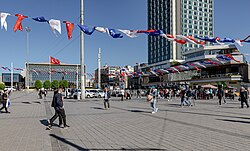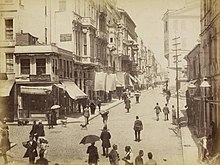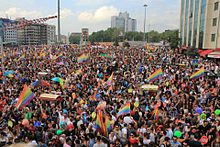Taksim Square
Taksim Square | |
|---|---|
| Public square | |
 | |
| Features | Republic Monument, Atatürk Cultural Center, Marmara Hotel, Taksim Square Mosque |
| Location | Beyoğlu, Istanbul |
| Coordinates: 41°02′13″N 28°59′09″E / 41.03694°N 28.98583°E | |
Taksim Square (
The square is flanked to the south by The Marmara Hotel, to the east by the
History

The word Taksim means "division" or "distribution" in Arabic. Taksim Square was originally the point where the main water lines from the north of Istanbul were collected and branched off to other parts of the city (hence the name.) This use for the area was established by Sultan Mahmud I. The square takes its name from the Ottoman era stone reservoir which is located along one side of the square.
Another significant building that once stood on the square was the 19th century
Taksim Gezi Park is a small green park in the midst of the concrete expanse of central Istanbul. In 2013, the city municipality, wanting to rebuild the old barracks as a shopping venue on the site of the park, began forcefully removing protesters who had set up camp in the park. After news spread of the police brutality, thousands of people rallied in the
Present day

Taksim is a main transportation hub and a popular destination for both tourists and residents of Istanbul.
Taksim's position was given an extra boost on June 29, 2006, when the new
Surrounding Taksim Square are numerous travel agencies, hotels, restaurants, pubs, and international fast food chains such as Pizza Hut, McDonald's, Subway, and Burger King. It is also home to some of Istanbul's grandest hotels including the InterContinental, the Divan, and The Marmara Hotel. Taksim used to be a favourite location for public events such as parades, New Year celebrations, and other social gatherings, although since 2016 permission has rarely been given for such gatherings.
Demonstrations and incidents
The square used to be an important venue for political protests.
- On February 16, 1969, some 150 leftist demonstrators were injured during clashes with right wing groups in what is known as "Bloody Sunday".
- In the events known as the Taksim Square massacre, 36 left-wing demonstrators were killed by unidentified and allegedly right-wing gunmen on the square during the Labour Day demonstrations of May 1, 1977.
- On 10 August 1982, Esenboga airport attack by the Armenian Secret Army for the Liberation of Armenia.[6]
- Taksim Square was the location of football riots in 2000 when two UEFA Cup semi-final first legmatch between the two teams.
- On October 31, 2010, a TAK militant, died, while 15 police officers and 17 civilians were injured.[7]

- A march to protest the Circassian genocide took place in May 2011.[citation needed]
Following many other violent incidents, all protests and demonstrations were banned and today police units maintain a round-the-clock presence to prevent any incidents. It is many years since either May Day or New Year's Day events were permitted to take place in the square, with much of the surrounding area usually fenced off for the day and the Metro station often closed to prevent people gathering.
Gezi Park protests

In 2013,

The demonstrators criticized Prime Minister (now President) Recep Tayyip Erdoğan for his uncompromising stance on this controversial issue and for the Turkish police's excessive use of force against the demonstrators.[11]
The large number of trees in the forests of northern Istanbul that were cut down to provide access to the Yavuz Sultan Selim Bridge (Third Bosphorus Bridge) and the new Istanbul International Airport[12][13][14][15] (the world's largest airport)[12][14][16] were other factors that triggered the Gezi Park protests. According to official Turkish government data, a total of 2,330,012[17][18] trees have been cut down to make way for the airport and its road connections; while a further 381,096[17][18] trees were cut down to make way for the highways leading to the Yavuz Sultan Selim Bridge.[18]
Gallery
-
Taksim Gezi Parkin 1943.
-
Areal view of Taksim Square after the demolition of the Taksim Artillery Barracks
-
Maxim Night Club, previously Cinemajik movie theater.
-
Taksim in the 1960s, with the Taşkışla Campus of Istanbul Technical University seen in the background.
-
Hagia Triada Greek Orthodox Church, near Taksim Square
-
Taksim Mosque was completed in May 2021
-
Atatürk Cultural Center at Taksim Square in 1999, with the entrance of the Taksim station of the Istanbul Metro.
-
Atatürk Cultural Center at Taksim Square in 2022, with the entrance of the Taksim station of the Istanbul Metro.
-
Renovated Atatürk Cultural Center at night
-
Renovated Atatürk Cultural Center at night
References
- ^ "Yok olan İstanbul Taksim Meydanı - Topçu Kışlası yeniden inşa ediliyor!". wowturkey.com.
- ^ "Police disperse protesters with pepper spray to continue partial demolition of Gezi Park". Today's Zaman. 2013-05-28. Archived from the original on 2013-06-23. Retrieved 2013-06-01.
- ^ Taksim-Kabataş funicular subway connection Archived 2007-05-17 at the Wayback Machine
- ^ SABAH, DAILY (2021-04-19). "Mosque to finally be unveiled in Istanbul's Taksim Square". Daily Sabah. Retrieved 2021-04-19.
- ISSN 0362-4331. Retrieved 2021-04-19.
- ^ Associated Press (August 16, 1982). "Armenian Dies Of Self-inflicted Burns". Observer-Reporter. Retrieved 2021-02-14.
- ^ "Suicide blast hits Istanbul". Al Jazeera. 31 October 2010. Retrieved 31 October 2010.
- ^ "Taksim park protests in 4th day amid police crackdown". Hurriyet Daily News. 31 May 2013. Retrieved 31 May 2013.
- ^ Seymour, Richard (31 May 2013). "Istanbul park protests sow the seeds of a Turkish spring". The Guardian.
- ^ Arango, Tim; Yeginsu, Ceylan (31 May 2013). "Peaceful Protest Over Istanbul Park Turns Violent as Police Crack Down". New York Times.
- ^ Thumann, Michael (31 May 2013). "Eine Ahnung von Tahrir in Istanbul" [An Inkling of Tahrir in Istanbul]. Die Zeit (in German).
- ^ a b Sharkov, Damien (14 August 2014). "Istanbul's New Erdoğan-Backed Airport to Be Named After... Erdoğan". Newsweek.
- ^ "İstanbul's new airport to be named after Erdoğan". Today's Zaman. 13 August 2014. Archived from the original on 18 August 2014.
- ^ a b Mezzofiore, Gianluca (14 August 2014). "Erdogan Airport: Istanbul's Super Hub 'to be Named After Turkey's President-Elect'".
- ^ "Turkey's largest airport is worthy of Recep Tayyip Erdoğan's name, minister says". Hürriyet Daily News.
- ^ "Dünyanın en büyük havalimanı İstanbul'a yapılıyor" [The World's Largest Airport is being Built in Istanbul]. Star (in Turkish). 23 January 2013. Retrieved 24 January 2013.
- ^ a b "İstanbul'da 2 milyon 700 bin ağaç kesilecek" [2 Million 700 Thousand Trees will be Cut Down in Istanbul]. oda TV (in Turkish). 16 September 2013.
- ^ a b c "3. köprü ve 3. havalimanı için 2 milyon 330 bin ağaç kesilecek!" [2.33 Million Trees will be Cut Down for the Third Bridge and the Third Airport!]. T24 (in Turkish). 17 September 2013. Archived from the original on 20 September 2013.










